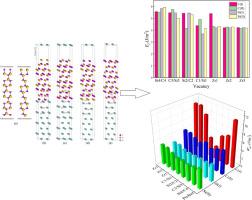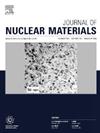不同空位对 Zr(0001)/SiC 紧密堆积界面性能的影响:第一原理研究
IF 2.8
2区 工程技术
Q3 MATERIALS SCIENCE, MULTIDISCIPLINARY
引用次数: 0
摘要
采用第一性原理研究了具有不同空位的 Zr(0001)/SiC 紧密堆积界面的结构、附着力和拉伸性能。从空位形成能的角度来看,SiC 涂层有利于增强 Zr 包层的抗辐照性能。当存在空位时,除了 Zr2 和 Zr3 空位外,引入其他空位会降低 Zr/SiC 界面的稳定性。C 端界面比 Si- 端界面更稳定。通过电子结构分析,界面上的空位主要减少了 Zr 和 SiC 之间的键,从而降低了界面的稳定性。SiC 一侧的空位间接改变了界面上共价键(成键或反成键)和离子键的强度或数量,从而错综复杂地降低了界面稳定性。在拉伸试验中,所有存在空位的界面的断裂仍然发生在 Zr 侧。SiC 侧的空位部分导致 Zr1-Zr2 或 Zr2-Zr3 之间的电子增加,从而加强了金属键,提高了界面的理想强度和延展性。本研究从成键机制的角度提供了一个新的视角,很好地揭示了不同空位对 Zr/SiC 界面性能的影响。本文章由计算机程序翻译,如有差异,请以英文原文为准。

The influence of different vacancies on Zr(0001)/SiC close-packed interface performance: A first-principles study
The first-principles were employed to investigate the structure, adhesion, and tensile properties of the Zr(0001)/SiC close-packed interface with different vacancies. From the perspective of vacancy formation energy, SiC coating is beneficial for enhancing the irradiation resistance of Zr cladding. When vacancies are present, except for the Zr2 and Zr3 vacancies, introducing other vacancies reduces the stability of Zr/SiC interfaces. The C-terminated interface is more stable than the Si-terminated interface. Through electronic structure analysis, vacancies at the interface primarily reduce the bonds between Zr and SiC, decreasing the interface stability. Vacancies on the side of SiC indirectly alter the strength or quantity of covalent (bonding or anti-bonding) and ionic bonds at the interface, thus intricately lowering the interface stability. In tensile tests, the cleavage of all interfaces with vacancies still occurs on the side of Zr. Vacancies on the SiC side partly lead to increased electrons between Zr1-Zr2 or Zr2-Zr3, strengthening the metallic bonds and enhancing the interface's ideal strength and ductility. The present study offers a novel perspective from the standpoint of bonding mechanisms, providing good insights into the effects of different vacancies on the performance of Zr/SiC interfaces.
求助全文
通过发布文献求助,成功后即可免费获取论文全文。
去求助
来源期刊

Journal of Nuclear Materials
工程技术-材料科学:综合
CiteScore
5.70
自引率
25.80%
发文量
601
审稿时长
63 days
期刊介绍:
The Journal of Nuclear Materials publishes high quality papers in materials research for nuclear applications, primarily fission reactors, fusion reactors, and similar environments including radiation areas of charged particle accelerators. Both original research and critical review papers covering experimental, theoretical, and computational aspects of either fundamental or applied nature are welcome.
The breadth of the field is such that a wide range of processes and properties in the field of materials science and engineering is of interest to the readership, spanning atom-scale processes, microstructures, thermodynamics, mechanical properties, physical properties, and corrosion, for example.
Topics covered by JNM
Fission reactor materials, including fuels, cladding, core structures, pressure vessels, coolant interactions with materials, moderator and control components, fission product behavior.
Materials aspects of the entire fuel cycle.
Materials aspects of the actinides and their compounds.
Performance of nuclear waste materials; materials aspects of the immobilization of wastes.
Fusion reactor materials, including first walls, blankets, insulators and magnets.
Neutron and charged particle radiation effects in materials, including defects, transmutations, microstructures, phase changes and macroscopic properties.
Interaction of plasmas, ion beams, electron beams and electromagnetic radiation with materials relevant to nuclear systems.
 求助内容:
求助内容: 应助结果提醒方式:
应助结果提醒方式:


